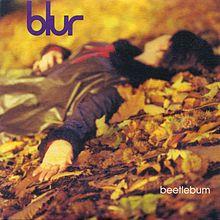Background
"Beetlebum" was inspired by heroin and the drug experiences Damon Albarn had with his then-girlfriend,Justine Frischmann of Elastica. [4] [5] Albarn reflected,"That whole period of a lot of people's lives was fairly muddied by heroin for a lot of people. And it's sort of,it's in that place. And a lot of stuff was at that time." [6] [7] He has stated in an interview with MTV that the song describes a complicated emotion,sort of "sleepy" and sort of "sexy". [8]
Rolling Stone hypothesises that the song's title is a reference to the phrase "chasing the beetle",further linking the song to Albarn's experimentation with drugs. Albarn commented,"I'm not sure what a Beetlebum is. It's just a word I sang when I played the song to myself. I asked the others if I should change it,but they said no. If it felt right,we decided that we wouldn't tidy it up like we've done in the past. It's about drugs basically." [9] Producer Stephen Street later commented,"I didn't know Beetlebum was about heroin. I thought it was just something he’d made up!" [10] A 2023 article in Dig! points out that "Beetlebaum" is "the name of a horse in comedian Spike Jones’parody of the William Tell Overture ,released as a single in 1948." [11]
Bassist Alex James explained of the song,"I think 'Beetlebum' is representative of the fact that as the band's got older,the songs have become more simple. Now we can play them with a lot more feeling." [12] Street similarly pointed to the song as a pivotal one for the band,commenting,"Listening back to Damon Albarn’s vocals on 'Beetlebum' for the first time,I had tears in my eyes,thinking:'This is special'." [13]
The song has been described as a "Beatles tribute" by several publications;Stephen Thomas Erlewine of AllMusic wrote that the song "[ran] through the White Album in the space of five minutes". [14]
Release
Because of its stylistic differences from Blur's previous singles,"Beetlebum" was expected to be a commercial disappointment. As James recalls,"When we first took it around,'Beetlebum' was perceived as commercial suicide." [12] Despite these fears,"Beetlebum" sold 120,000 copies in the UK during its first week on sale,becoming the band's second number-one single (after "Country House"). [15] [16] The song also reached the top 10 in several European countries as well as number 13 on the Canadian RPM Alternative 30 ranking. [17]
In addition to its release on Blur ,the song has appeared on compilations such as Blur:The Best Of and Midlife:A Beginner's Guide to Blur . It was remixed by Moby for the remix album Bustin' + Dronin' . [7]
This page is based on this
Wikipedia article Text is available under the
CC BY-SA 4.0 license; additional terms may apply.
Images, videos and audio are available under their respective licenses.
